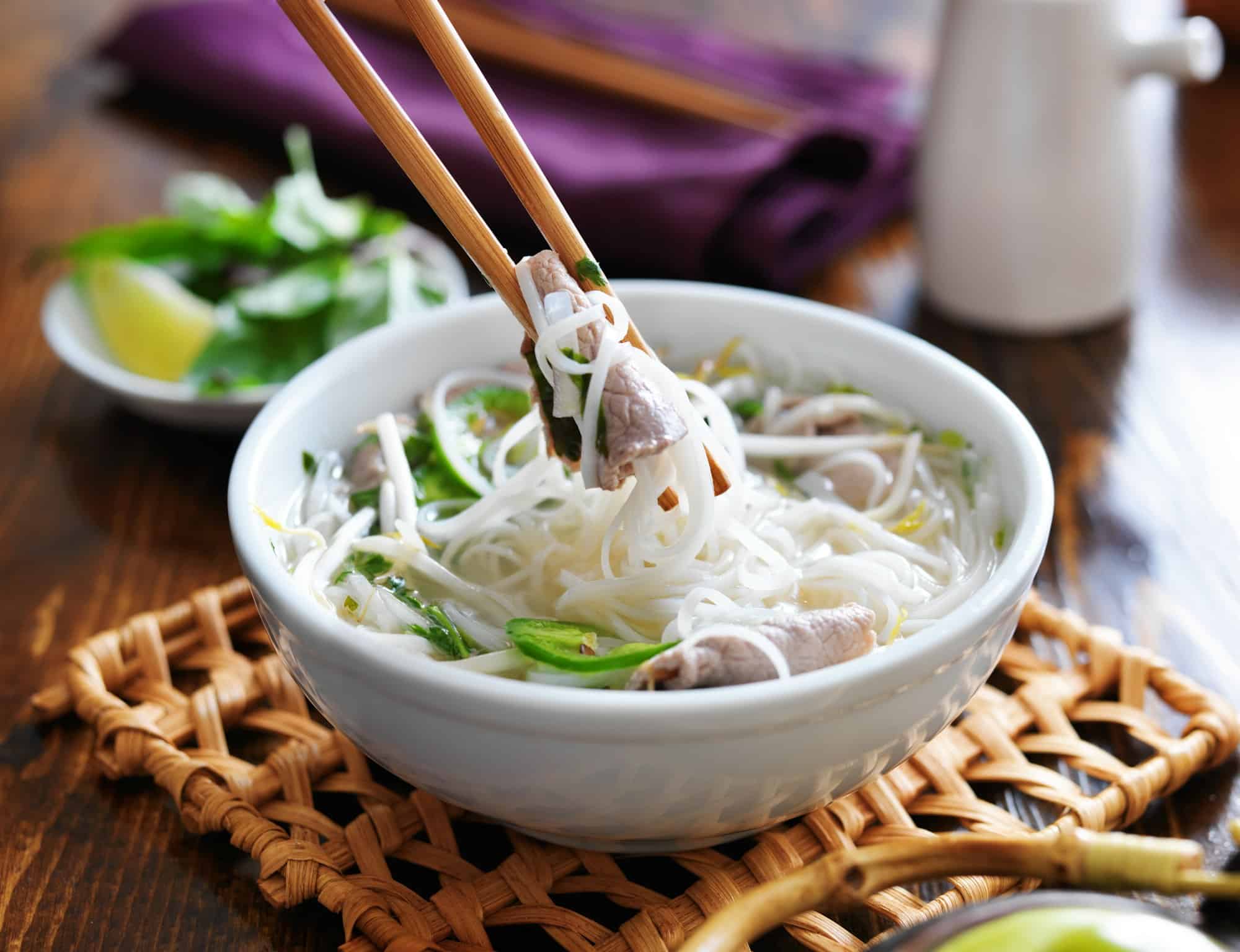Pho is a traditional Vietnamese soup that’s known for its aromatic spices, hearty broth, and satiating noodles. However, the classic recipe often calls for beef or chicken, making it a non-option for those who abide by a vegan or vegetarian lifestyle. But don’t let this deter you; it’s entirely possible to create an equally flavorful vegetarian pho at home with a richness that rivals the traditional recipe. It all boils down to the broth. If you have ever wondered how to perfect your vegan pho recipe, then this article is for you.
The Broth: The Heart of the Pho
The broth is no doubt the heart of any pho recipe. This is where the magic happens, where the flavors meld together to create a depth that awakens the senses. It’s more than just throwing together vegetables and water – a flavorful broth demands time, quality ingredients, and a careful balance of spices.
Topic to read : Can You Prepare an Authentic Thai Green Curry with Fresh Lemongrass and Galangal?
Begin with the base. A common combination includes onion, ginger, and garlic. These three ingredients hold a powerful flavor profile that creates a robust foundation for the broth. Saute them until golden, allowing the natural sugars to caramelize and add another dimension of flavor.
Spices are next. Traditional pho uses star anise, cloves, and cinnamon. Don’t be afraid to toast these spices beforehand. The heat draws out the essential oils, enhancing their aroma and thus, their contribution to the soup.
Also read : What Techniques Will Give You Perfectly Crispy Duck Fat Roasted Potatoes?
The "umami" factor is crucial in vegetarian pho, given that we don’t have meat to rely on. This is where mushrooms come into play. They are a natural source of glutamate, which gives that savory depth we often associate with non-vegetarian soups.
The Noodles: Not Just a Filling
The noodles in pho are not just there to fill you up. They play a crucial role in balancing the flavors of the dish. Their neutral taste complements the rich broth, providing a delicate canvas that allows the soup’s flavors to shine.
When dealing with rice noodles, remember that they can quickly turn from perfectly tender to overly mushy. The trick here is to cook them separately and add them to the soup just before serving. This not only prevents the noodles from overcooking but also keeps the broth clear, as rice noodles are notorious for releasing starch.
Toppings: The Final Layer of Flavor
The last layer of flavor in your vegetarian pho comes from the toppings. Common toppings include bean sprouts, fresh herbs, lime wedges, and hot sauce. These add texture and a pop of freshness to offset the hearty broth.
Tofu is a great addition to your vegetarian pho. It adds protein and has the unique ability to absorb the flavors of the broth, making every bite satisfying. Remember to press your tofu beforehand to remove excess water, allowing it to soak up the soup better.
Time: The Secret Ingredient
Patience is key when cooking pho. It may take up to an hour or so for the broth to be ready, but don’t be tempted to rush this process. The slow simmer allows the ingredients to release their full potential, creating a broth that’s truly worth the wait. Resist the urge to crank up the heat; a low and slow approach will guarantee a clear and flavorful broth.
Remember, the longer you let your broth simmer, the more robust the flavors will be. This is not a meal to prepare when you’re in a rush. But once you take the first sip of your homemade broth, you’ll understand why this extra time is essential.
Seasoning: The Final Touch
Once your broth has cooked for an appropriate amount of time, it’s time to season. Fish sauce is typically used in traditional pho, but a vegan alternative like tamari or soy sauce can be used instead. This adds a much-needed saltiness and further enhances the umami flavor.
It’s important to taste your broth and adjust the seasoning as needed before serving. Everyone’s palate is different, and what may be perfect for one might be bland or too salty for another.
Making vegetarian pho at home can seem like a daunting task, but with quality ingredients, a balance of spices, and time on your side, you’ll be able to create a soup that’s just as flavorful as the traditional recipe. Remember, the secret to a flavorful vegetarian pho lies in the homemade stock, so don’t skimp on the ingredients or the simmering time. After all, good things come to those who wait!
Additional Ingredients: Adding More Nuance to Your Vegan Pho
Apart from the crucial broth, noodles, and toppings, there are other ingredients that can add more complexity to your vegan pho. These can help elevate your soup from a simple noodle dish to a culinary masterpiece.
Green onions and coriander seeds are often used to aromatize the broth. Their vibrant flavors help create an interesting contrast with the earthiness of the shiitake mushrooms. These two ingredients can be added to the broth during the simmering process, allowing their flavors to seep into every corner of the dish.
Hoisin sauce and Thai basil are often served alongside the soup, allowing diners to customize their dishes to their liking. The sweet and spicy hoisin sauce can add a delightful kick to the broth, while the fresh Thai basil leaves can provide a refreshing counterpoint to the soup’s rich flavors.
While not traditional, some cooks also add bok choy to their pho. This leafy green is a delicious source of texture and nutrition. It can be quickly blanched and placed on top of the soup just before serving.
Lastly, for those who follow a gluten-free diet, there is good news. Pho is naturally gluten-free, especially when you use tamari as a substitute for fish sauce. Just make sure to check the labels of any pre-packaged ingredients, like rice noodles, to ensure they don’t contain any hidden sources of gluten.
Slow Cooker: A Convenient Alternative
If you’re short on time or just want a more hands-off approach, you can use a slow cooker for your vegan pho.
Start by sautéing the onion, ginger, and garlic on the stove. Once golden, transfer them to the slow cooker, along with the toasted spices and mushrooms. Pour in enough water to cover all the ingredients, and let it simmer on low for about six to eight hours.
Using a slow cooker can help deepen the flavors of the broth, as it allows for a longer simmering time. Plus, it frees up your time, so you can focus on preparing the noodles, toppings, or other dishes.
Remember that even with a slow cooker, you should still add the noodles and toppings only before serving. This ensures that the noodles remain firm and the toppings fresh.
Conclusion: Mastering the Art of Vegan Pho
Creating a flavorful vegetarian pho at home may seem challenging, but with careful selection and preparation of ingredients, you can master this Vietnamese classic. The secret lies in crafting a rich, homemade stock, complete with aromatic spices like star anise and coriander seeds, umami-rich shiitake mushrooms, and foundational elements like onion and ginger.
Remember, patience is key. Allow the broth to simmer slowly and gently, either on the stove or in a slow cooker, to extract the full depth of flavors. And when it comes to serving, don’t forget the importance of perfectly cooked rice noodles and a variety of fresh, vibrant toppings.
Whether you’re a seasoned cook or a newbie in the kitchen, this plant-based noodle soup is a flavorful, satisfying dish worth mastering. So why wait? Get your ingredients ready, set your stove or slow cooker, and start the journey of creating your authentic, homemade vegan pho.











